On the late morning of Friday, December 27, 1929, the alarm was sounded after a brazen robbery was reported in downtown Butler, Pennsylvania. Several suspects were observed fleeing west in a green Chevrolet sedan towards New Castle on the Butler Road (old Route 422). Camped out along the road in Shenango Township was a motorcycle and attached sidecar manned by Corporal Brady C. Paul and Private Ernest C. Moore, two officers of the Pennsylvania State Highway Patrol. Paul and Moore were on alert as they began stopping and checking the few cars headed west. Meanwhile, the suspects’ car barreled west on a collision course with the two officers. What took place next set off an intense manhunt that enthralled the citizens of Lawrence County as well as the entire nation.
Irene Crawford, the youngest of eight surviving children, was born on February 17, 1909, in the town of Benwood, West Virginia, just south of Wheeling. When she was eight her mother Martha died and she subsequently spent time living with several relatives including her older sister Ruby (Crawford) Shrader. As a child she was prone to petty theft, which intensified as she grew older. In 1925, when she was fifteen, she married Homer Shrader, the brother of her brother-in-law Ray Shrader. Together they had a son named Donald J. Shrader. About a year and a half later they split and were soon divorced.
Irene Crawford Shrader, who began using the surname Schroeder at some point, bounced around for a time before settling down and finding work as a waitress in Wheeling. It was here that the twenty-year-old Schroeder started a secret romance with a married man named Walter “Glenn” Dague, a former Methodist Sunday School teacher and Boy Scout leader currently employed as a used car salesman. Dague, a World War I veteran who was thirteen years her senior, left his wife and two children in April 1929 to be with Schroeder. He make matters worse he lost his job soon after this.
Together, Schroeder and Dague, along with her four-year-old son Donnie, hit the road looking for work in various locations in West Virginia, Pennsylvania, and New York. Unable to find gainful employment they apparently decided to resort to a life of crime. In about August 1929 they purchased several revolvers from pawn shops in Pittsburgh. They (including Donnie) hit the road again this time robbing numerous gas stations and small stores in Illinois, Missouri, Tennessee, Kentucky, Ohio, and Pennsylvania. By the end of year they were safely back in Wheeling. On Thursday, December 26, 1929, Schroeder and Dague, along with Schroeder’s older brother Tom Crawford and son Donnie, departed West Virginia headed up into Pennsylvania. After a tour of downtown Pittsburgh they made their way up to Butler, where they spent the night under an assumed name at the Arlington Hotel on South Main Street.
The next morning, apparently on a whim, they decided to rob the nearby P. H. Butler Company, affiliated with a grocery chain based out of Pittsburgh. At about 11:15am Schroeder and Dague entered the store to do the dirty work, while Crawford stood guard outside. Donnie waited in the car alone. Dague tied up and gagged the manager, while Schroeder took his wallet and emptied out the contents of the cash register. In the midst of this crime an elderly male costumer entered the store unaware of what was happening inside. He was bound and gagged and robbed of his wallet as well. With Dague at the wheel of the getaway car the suspects soon sped off towards New Castle.
Meanwhile, at about 11:30am, State Highway Patrol officials in Butler made a call to the Colonial Hotel on East Washington Street in New Castle. The hotel, owned by John Crowl and his wife Molly, was the headquarters and living quarters of the small local detachment of the State Highway Patrol. The State Highway Patrol, established in 1923 to patrol the growing highway system within Pennsylvania, was later merged into the State Police in 1937. Taking the phone call was twenty-five-year-old Corporal Paul, a four-year veteran of the force. Paul was told about the robbery and instructed that the three culprits were possibly headed their way. Paul and his partner Ernest Moore jumped on their motorcycle (with attached sidecar) and drove a short distance to the east, where they took up a position along the Butler Road just west of the intersection with Baldwin Road.
Paul and Moore had already checked a handful of vehicles when a sedan that fit the suspects’ vehicle approached the checkpoint at about 12:00 noon. As the vehicle came to a halt they saw the three adult occupants, but apparently dropped their guard when they saw a young boy standing up in the front seat. Paul went up to the driver’s side window and asked Dague for some identification, while Moore walked around to check the rear of the vehicle. Accounts vary but the official record of what happened next goes something like this.
Dague immediately drew his weapon and Paul scrambled to get away – bumping into a startled Moore as he retreated. Dague and Schroeder quickly jumped out the driver’s side door with revolvers drawn. Dague apparently fired a shot that hit Paul in the left leg. Moore attempted to go around the rear to the passenger side, but Crawford fired from the back seat and shot Moore across the nose. Moore drew his service revolver but was pinned down behind the car drawing fire from both Dague and Crawford. Moore was struck in the head a second time, this time with a glancing blow from a bullet. Meanwhile, a calm Schroeder pointed her revolver straight at Paul. Paul slowly backed away with his hands slightly up as Schroeder bore down on him. She fired once and struck him in the arm, but Paul simply clutched the wound and continued backing up. She fired again striking him in the abdomen and he dropped to his knees. Schroeder and Dague rushed back into the vehicle and sped off, while a staggering Paul took refuge behind a telephone pole and returned fire at the fleeing suspects. Moore, who never fired a round in the exchange, lost consciousness and lay in the road.
Several nearby residents witnessed the shooting and saw the suspects’ car flee westward. Both police officers got back on their feet and staggered around while they attempted to regain their bearings. A local truck driver named Charles Book, who also saw the shooting from a distance, arrived on the scene first. Paul climbed into his truck as they rushed to Howard Kelley’s Funeral Home on East Washington Street across from the Colonial Hotel. From there a weakened Paul was transported by ambulance to Jameson Memorial Hospital. Two female college students helped Moore into their car and also rushed him to the hospital. Paul was rushed into surgery where doctors prepared to operate on him. It was quickly apparent that little could be done for Paul. Molly Crowl, who was a like a mother hen to the officers staying at the Colonial Hotel, clutched his hand.
Molly later testified in court, “I took hold of Paul’s hand and asked him if he knew me. He said yes, and was glad that I was there when he was dying. He asked me to get him something for the pain. He looked at me again and said. Molly, I am dying. Tell the boys I did my duty, I did the best I could. Dr. Kaplan came in and gave him aid. Then Brady said. Molly, you’ll soon see my mother. Kiss her goodbye for me. I asked Dr. Kaplan if there wasn’t something to be done, and he shook his head. Paul’s breathing was coming with difficulty.” At about 12:55pm Paul took his last breath and slipped away. Moore, who was extremely fortunate for being shot in the head twice, was treated and made a full recovery.
After the incident on the Butler Road the suspects fled into New Castle, where they flagged down a Chrysler sedan near the Blair Strip Steel plant along Cascade Street. They robbed the two occupants of their valuables, abandoned their own vehicle and jumped into the Chrysler, and sped off into the heart of New Castle. They made their way south along Route 18, possibly stopping in Monaca for dinner, and were back in Wheeling later that night. They hid the stolen Chrysler in rented garage and soon parted ways with Tom Crawford. After dropping young Donnie off with Schroeder’s father the murderous duo hit the road again – this time headed west into Ohio.
Authorities in New Castle had no idea of the identities of the suspects, other than they were looking for two men, a woman, and a small child. Investigators combed over the abandoned Chevrolet sedan and found several clues. The car was reported stolen from St. Louis, Missouri, but turned out to have a license plate stolen from Toledo, Ohio. The most promising lead was a sales receipt for a red scarf from a store in Wheeling. State Police investigators descended on Wheeling and questioned the employees of the store. It was apparently determined that a red scarf was recently purchased by a regular costumer named Irene Shrader (or Schroeder), who had several family members living in the vicinity. Police began tracking down her whereabouts.
A memorial service was held for Corporal Paul at the Colonial Hotel on Saturday, December 28, and the next day his fellow motorcycle troopers escorted his remains to his hometown of Hickory in Washington County. A funeral service, attended by members of the Highway Patrol and the State Police, was held and he was laid to rest with full military honors in Mount Prospect Cemetery.
On December 31, 1929, local investigators arrived at the home of Ray and Ruby Shrader in Bellaire, Ohio, where Schroeder’s father had since taken his grandson Donnie. While questioning the family the officials were astonished when Donnie appeared from a back room and said something to the effect that, “Mommy shot a cop just like you!” They questioned Donnie alone and now believed Irene Schroeder was the woman they were seeking! Donnie indicated his Uncle Tom (Crawford) and “Papa” were also involved. Police initially though “Papa” might be Irene’s husband Homer Shrader, but learned he had previously relocated to California. It took another day or two but police soon identified W. Glenn Dague as Schroeder’s companion.
Meanwhile, on Saturday, December 28, Schroeder and Dague drove non-stop through Ohio and finally stopped in Louisville, Kentucky. From there they continued west for two days and rested again in St. Louis, Missouri. Authorities in the area were on alert as it was learned Schroeder had another brother named Arthur serving a sentence in a local prison. It was here that they first learned they had been publicly identified as suspects. Newspaper accounts across the country detailed their exploits and touted Schroeder as the “Trigger Blonde,” “Iron Irene,” or the “Gun-Girl.” Her son Donnie became a media sensation as well.
On the late evening of January 4, 1930, a St. Louis police officer named William Kiessling noticed their car moving slowly along a secondary street. After pulling their vehicle over Dague shot at Kiessling several times at close range but somehow missed him. A hand-to-hand scuffle ensued between the two men. Apparently as Dague was pinned down Schroeder came to his rescue pointing her steel blue revolver at the officer’s head. Kiessling later testified that Schroeder barked, “You son of a bitch! Come on or I’ll kill you.” She also took the officer’s service revolver and the duo quickly sped off.
They veered southward passing through Oklahoma and into Texas, apparently robbing a handful of gas stations along the way. They also picked up unsuspecting hitchhikers who they sent into stores to pick up groceries and other supplies. In Texas they picked up a hitchhiker named Vernon Ackerman (aka Joe “Red” Wells), an ex-convict and scam artist from Oklahoma who fit right in with them. They trio continued westward passing through New Mexico and into Arizona.
In Florence, Arizona, southeast of Phoenix, they made a stop on Tuesday, January 14, at a gas station for fuel and food. Schroeder waited in the car while the two men went inside the gas station. Schroeder was confronted by a Pinal County Deputy Sheriff named Joe Chapman. Dague and Ackerman returned from the store and the trio took Chapman hostage and drove off. The group soon encountered a roadblock in Chandler and a gun battle ensued. Chapman and a Maricopa County Sheriff’s Deputy named R. Lee Wright were wounded in the exchange. Chapman managed to escape his captors (or was thrown out) during the fight, but the three fugitives also evaded capture.
The trio soon abandoned their vehicle, which had a Kentucky license plate, and fled on foot into the foothills of the Estrella Mountains near Laveen, Arizona. Maricopa County Sheriff Charles H. Wright organized a large posse of local lawmen including authorities from the local Pima Indian reservation. An aircraft was also utilized to help spot the fugitives from above. The determined lawman pursued the trio into the foothills and soon had them surrounded. An intense gun battle ensued but after a few hours, with their ammunition and hope of escape apparently exhausted, the three of them surrendered. A Pima Indian identified as “Chief Sindust” rode down the hills with Irene on his horse and her two male cohorts handcuffed and walking alongside.
The trio were taken to the Maricopa County Jail but claimed they were not the suspects the police in Pennsylvania were searching for. When Schroeder was shown a photo of her son Donnie she reportedly replied in a calm voice, “He doesn’t belong to me.” It took a few days but Dague finally confessed about their true identities and their involvement in the shooting of Corporal Paul. He denied he fired the fatal shot and said Schroeder was the ringleader of the operation. Police were also bewildered when they learned the other man in custody was not Tom Crawford as they initially suspected. Authorities in Pennsylvania and Arizona briefly sparred over extradition proceedings, but an agreement was soon worked out. Schroeder and Dague would be returned to New Castle, while Ackerman would stand trial in Arizona. Schroeder and Dague later indicated that Crawford was killed in the shootout on the Butler Road and they buried him in West Virginia, but police believed he was still at large.
A group of eight police officials, including wounded police officer Ernest Moore, and a few newspapermen from Lawrence County soon arrived in Arizona, tasked with returning the duo to New Castle. The departed Phoenix on Tuesday, January 21, and encountered large crowds of spectators and reporters at the various train stations where they stopped along the way. They finally arrived at the Pittsburgh & Lake Erie (P&LE) train station at New Castle Junction on the evening of Friday, January 24. Several thousand people were gathered at the train station to catch a glimpse of the bandits. The police whisked the duo away to the Lawrence County Jail.
On Tuesday, January 28, 1930, they were both quietly arraigned before Alderman William E. Marshall on various charges including the murder of Corporal Brady Paul. Both refused to enter a plea without an attorney present so a plea of “not guilty” was entered for them. They were soon both denied bail and ordered to undergo separate first degree murder trials beginning in March. Things got even more complicated when word came from Arizona that Deputy Lee Wright died of his injuries on January 29.
It was determined that Schroeder and Dague would both be prosecuted by local District Attorney John S. Powers with assistance with high-powered Special Counsel Charles J. Margiotti, who later served as the District Attorney for the Commonwealth of Pennsylvania. It was no surprise that the prosecution was seeking the death penalty for both suspects. Schroeder would become only the tenth woman ever tried on first degree murder charges in Lawrence County, but so far the previous nine had escaped the death penalty. Newspapermen and curiosity seekers flocked to New Castle and local hotels were sold out for months. Among those present was a young New York City-based reporter named Edward V. Sullivan, a future television personality best known for hosting The Ed Sullivan Show from 1948-1971.
Schroeder’s trial, in the courtroom of Judge R. Lawrence Hildebrand, was first and commenced on Wednesday, March 12, 1930. Schroeder and Dague shared a skilled legal team led by local attorney Thomas W. Dickey, a former District Attorney who later served as a Lawrence County Judge, and Farrell-area attorney Benjamin Jarrett, a former state senator and future member of the U.S. House of Representatives. Seventy-seven witnesses testified against her in the trial, which included night sessions to hasten the process. Schroeder denied firing the fatal shot that killed Corporal Paul. Apparently the fatal bullet that killed Paul was never located, so ballistic evidence that might have indicated who fired that shot was never developed. Her defense team said she had some issues as a child that led to her irresistible thrill to steal cars and rob stores as an adult. It was also claimed she might be mentally ill or possibly pregnant with Dague’s child.
The proceedings wrapped up on Friday, March 21, with the closing arguments by Special Counsel Margiotti and then the defense team. An account in the New Castle News reads, “The room was hushed, saved for a few stifled sobs of many spectators and as he (Margiotti) dramatically declared “if you do not give this woman the chair, then the death penalty in Pennsylvania should be abolished” the very air seemed to be charged. Somehow that atmosphere boded no good for the defendant, Irene Schroeder.” The defense team, overwhelmed with the evidence presented against Schroeder, pleaded that her young life be spared. The jury was tasked with not only deciding her guilt, but (if they found her guilty) they also had to decide between a sentence of life imprisonment or the death penalty. The jury returned after a few hours, finding her guilty for the murder of Corporal Paul and imposing the maximum penalty of death.
Dague’s trial commenced on Monday, March 24, 1930, and was really just a formality. Dague’s legal team tried to make an argument that he was controlled by the dominating Schroeder and under her spell so to speak. It was hoped that Dague could at least avoid the death penalty as Schroeder had already been convicted for killing Corporal Paul. Prosecutors made the point that even though they believed Schroeder fired the fatal shot that killed Paul, Dague also shot at the police officer and was just as guilty. Just over a week later the jury returned with the same verdict and sentence as was given Schroeder. Both were soon scheduled for state execution pending their appeals.
Meanwhile, back in Phoenix, Arizona, their accomplice Vernon Ackerman went on trial in May 1930 for the murder of Deputy Wright. He was found guilty of murder, but the jury decided against the death penalty and gave him life in prison. Apparently he died in the state prison at Florence, Arizona, in October 1931. Schroeder’s brother Tom Crawford, the true accomplice in the shootout on the Butler Road, evaded capture for the time being.
Schroeder and Dague were confined in the Lawrence County Jail while their legal team filed various appeals over the next year. On Wednesday, February 17, 1931, Schroeder, on her twenty-second birthday, was allowed to see her son Donnie for the last time. Their final appeal was exhausted the next day when the State Board of Pardons denied a motion to overturn their death sentences. The coming Saturday they were transported to the Rockview Penitentiary in Bellafonte, Pennsylvania, where the state maintained its electrocution chamber. On the morning of Monday, February 23, Schroeder was led to the electric chair by a small group of advisors and prison officials. Pennsylvania had replaced the gallows with the electric chair as the preferred method of execution back in 1913, and Schroeder was about to become the first woman ever put to death by electrocution in the state. In fact she was only the fourth woman ever put to death by electrocution in the entire country.
The New Castle News reported, “No hysteria, no sobs, no pleas for human mercy… There was almost a carefree attitude about Irene… There was no muscular tremors as she entered that cold, dank cheerless room, no drawing back in horror, nothing but a matter of fact attitude that seemed to be-speak a haste to get the whole thing over… As the Rev. Lauer (prison chaplain Carl F. Lauer) walked slowly into the room ahead of her he repeated the Twenty Third Psalm. As the gruesome leathern mask went down over her face, obliterating almost all signs of it, not even did she wince or cry.” A few moments later, at 7:05am, Schroeder was declared dead. Dague was marched out in similar fashion soon after and declared dead at 7:13am.
Their executioner was Robert G. Elliott, a prolific New York-based executioner known to have taken part in 387 executions in six states during his lifetime. Over time Elliott put to death several famous criminals to include Nicola Sacco and Bartolomeo Vanzetti (1927), Ruth Snyder and Henry Judd Grey (1928), and Bruno Hauptmann (1936). Schroeder’s remains were shipped by train back to West Virginia and buried in the family plot in Mt. Rose Cemetery (now Greenwood Cemetery) in Bellaire, Ohio. Dague’s widow Theresa, who remained loyal to her husband throughout the trial process, refused to allow him to be buried with Schroeder. She claimed his remains and had him buried next to his mother and sister in the Sand Hill Cemetery near Wheeling, West Virginia.
Irene’s brother Tom Crawford was finally cornered in southeast Missouri in early 1933. Crawford and an accomplice robbed a restaurant in Morehouse, Missouri, on Monday, January 2, 1933. The next day the police tracked them to a hideout in nearby Cape Girardeau, where the two fugitives were killed during a protracted gun battle. It took about a week but Crawford was finally identified by fingerprint records on file from a previous arrest.
Irene Schroeder’s son Donnie Shrader was raised by his various family members and returned to relative obscurity once the excitement died down. As he grew up it seems he did his best to hide his past from those he knew. He joined the military and saw service during World War II and Korea and later worked as an engineer supporting the American space program. His first marriage, which produced a child during World War II, ended when his new bride’s parents apparently found out who he was. He soon remarried and had three more children. Don lived a long life and passed away in Orlando, Florida, in late December 2009, at the age of eighty-four.
The wild exploits of Schroeder and Dague, sensationalized in many true crime-type comic books during the 1930’s, pre-date the celebrity of other “Public Enemy Era” bandits to include John Dillinger and the gang headed by Bonnie Parker and Clyde Barrow. Some issue has been made about whether it was Schroeder or Dague (or even Crawford) that fired the actual shot that killed Brady Paul and if it was lawful for both of them to be put to death. The bottom line is that their actions, whether directly or indirectly, led to the death of two police officers (Corporal Paul in Pennsylvania and Deputy Wright in Arizona) and as a consequence they paid the ultimate price for their choices.
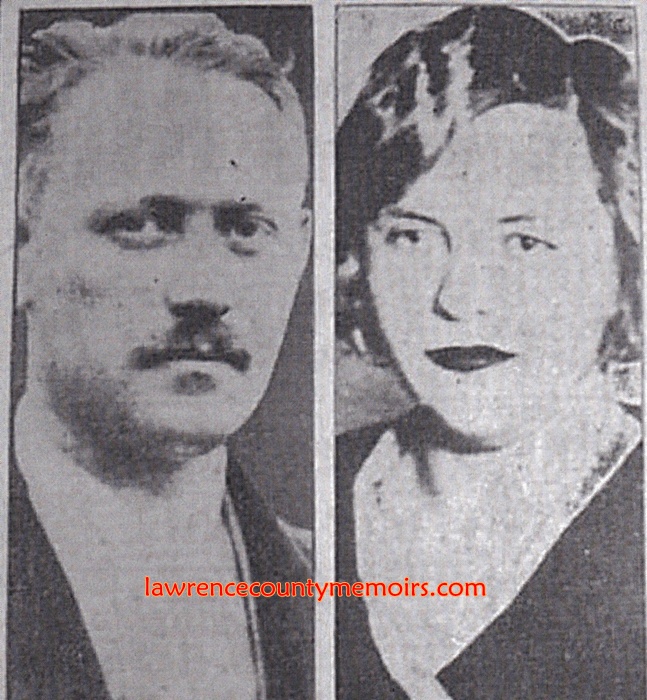 After they met in Wheeling WV in April 1929 the duo of Glenn Dague, a car salesman, and Irene Schroeder, a waitress, seemed destined for trouble. Within a few months they purchased some firearms and began robbing small stores and gas stations throughout the neighboring states. The beginning of the end came on December 27, 1929, when they robbed a store in Butler and engaged in a fatal shootout with police officers in Shenango Township. Over the next three weeks they blazed a trail of mayhem westward across the country until they were finally captured near Phoenix AZ. (c1930) Full Size |
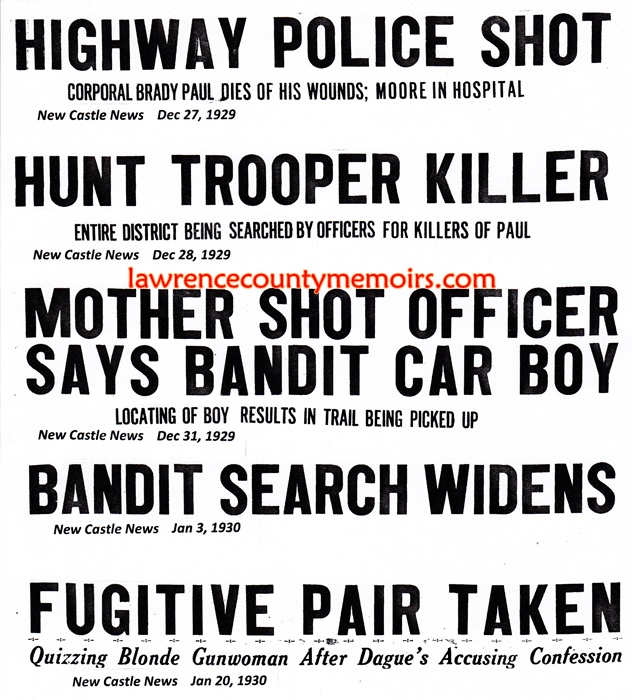 |
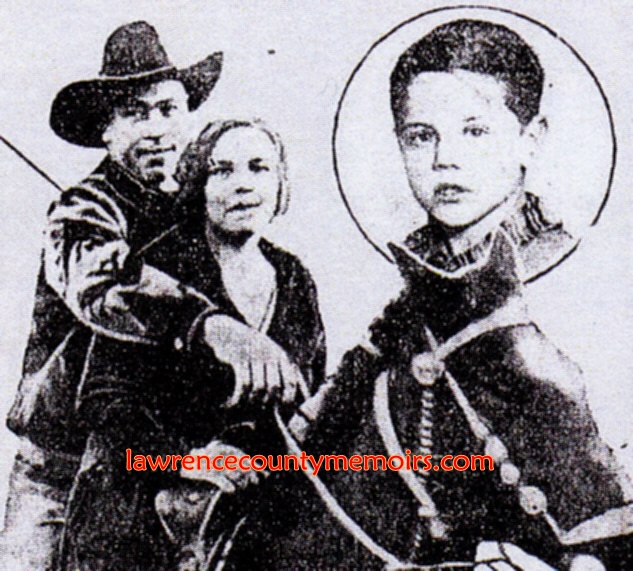 Irene Schroeder, just after being captured, is led down the mountain on horseback by a member of the reservation police unit. The inset photo shows her son Donnie. (Jan 1931) |
 About a week after their capture in Arizona on January 14, 1930, the duo was transported back to New Castle to stand trial for the murder of Cpl. Brady Paul. New Castle took on a circus-like atmosphere as numerous reporters and throngs of spectators packed the downtown area for the next few months. The wild exploits of Schroeder and Dague pre-date other “Public Enemy Era” bandits to include the infamous gang headed by Bonnie Parker and Clyde Barrow. (1930) Full Size |
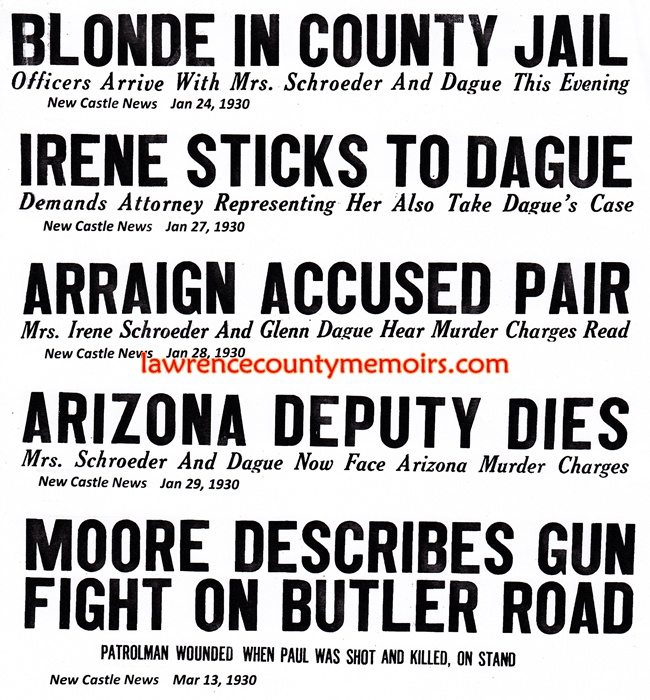 |
 Irene Schroeder is led through the Lawrence County Jail by Sheriff Frank N. Johnston and jail matron (and his wife) Olive Johnston. In the background are Sheriff’s Deputy William Reynolds (on left) and Jail Warden Andy Venditto. (1930) Full Size |
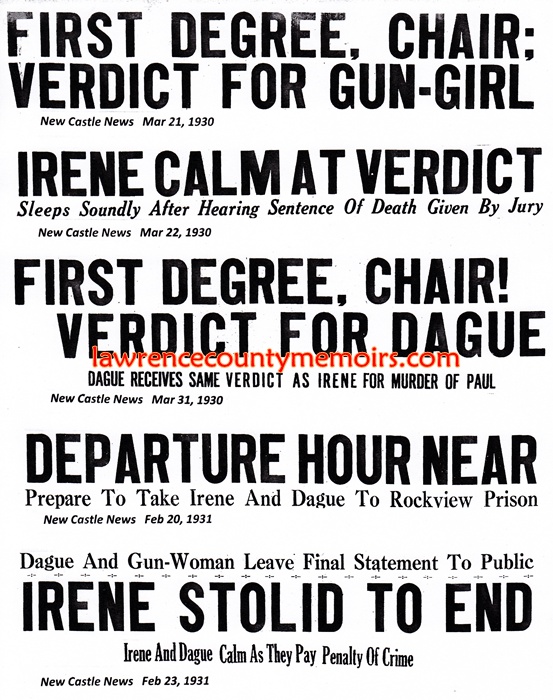 |
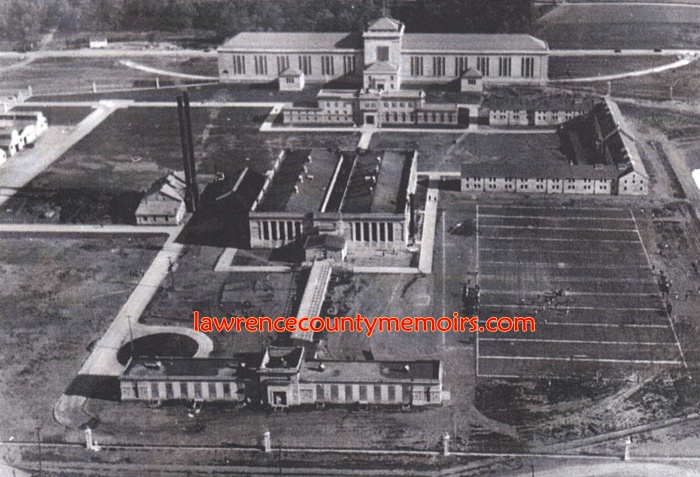 After their separate trials held in March 1930 both Schroeder and Dague were found guilty of the murder of Cpl. Paul and sentenced to death. They were sent to Rockview Penitentiary (shown above) in Bellefonte PA two days before they were executed in the electric chair on the morning of Monday, February 23, 1931. In 1913 the Commonwealth replaced the gallows with the electric chair as the preferred method of execution, and Schroeder was the first woman ever put to death by electrocution in Pennsylvania. In fact she was only the fourth woman ever put to death by electrocution in the entire country. (c1970) Full Size |
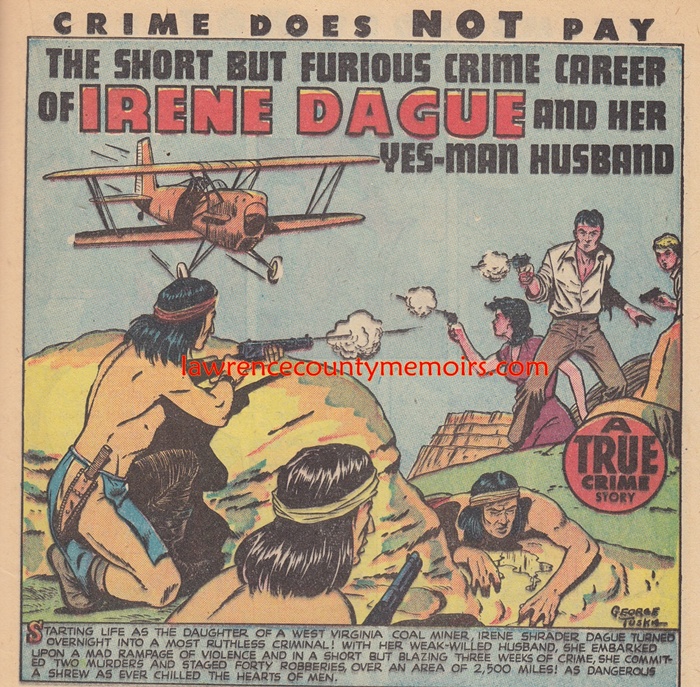 This is the opening panel of a story in the November 1947 issue of the Lev Gleason comic book Crime Does Not Pay, greatly exaggerating the facts while depicting Irene Schroeder as a cold-blooded killer and the mastermind of the crime spree. Another story in the same issue features female bandit Bonnie Parker. Full Size |
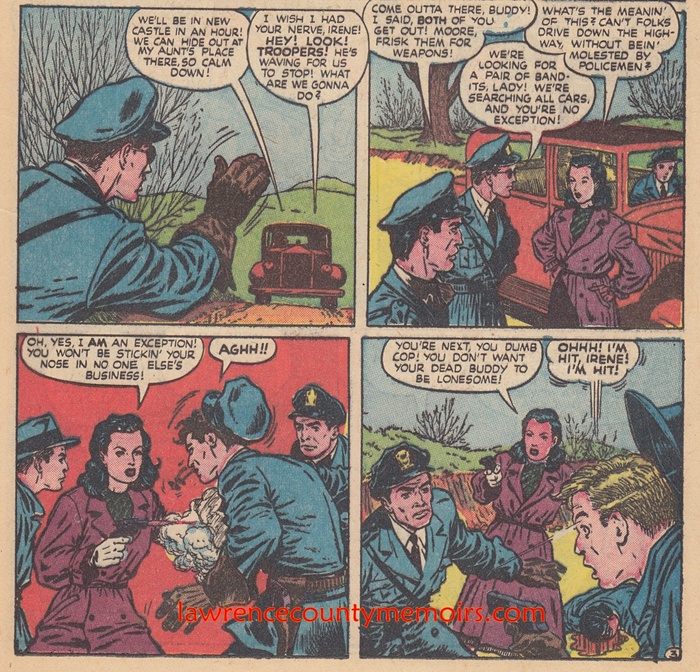 This panel from the same story of Irene Schroeder depicts the shooting of officers Paul and Moore on the Old Butler Road. Full Size |




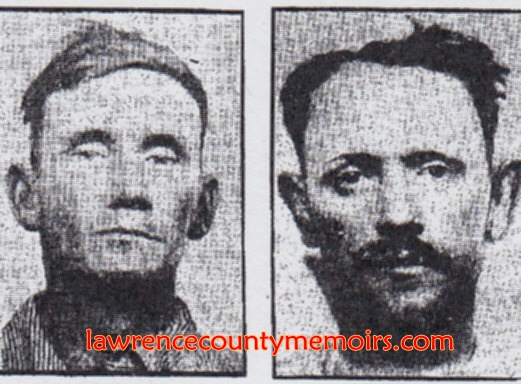
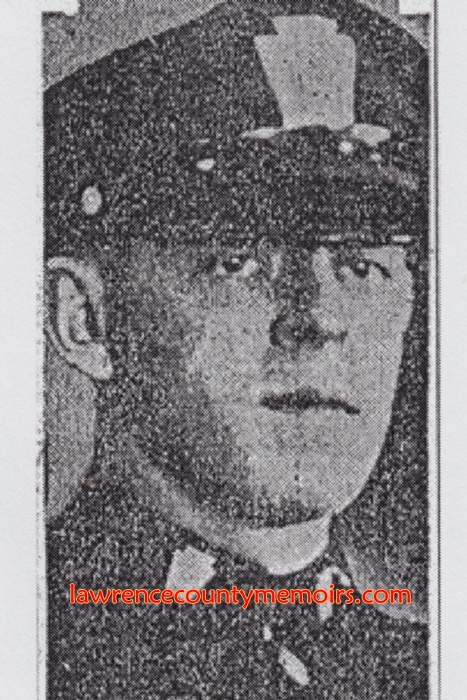
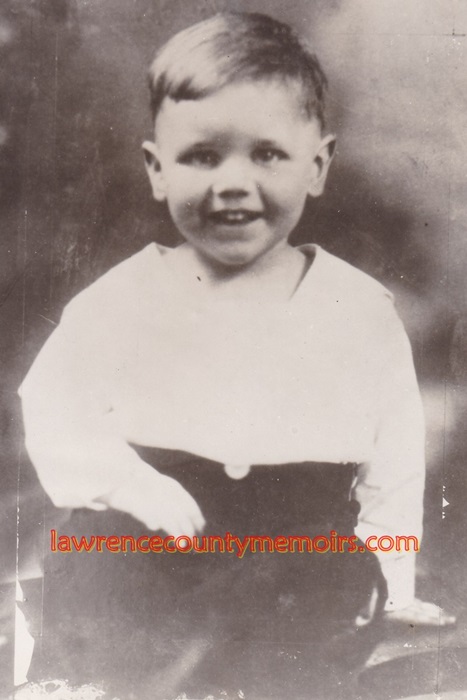
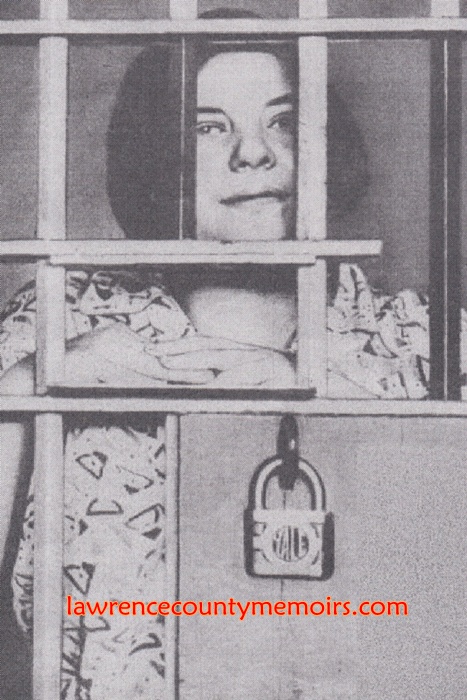
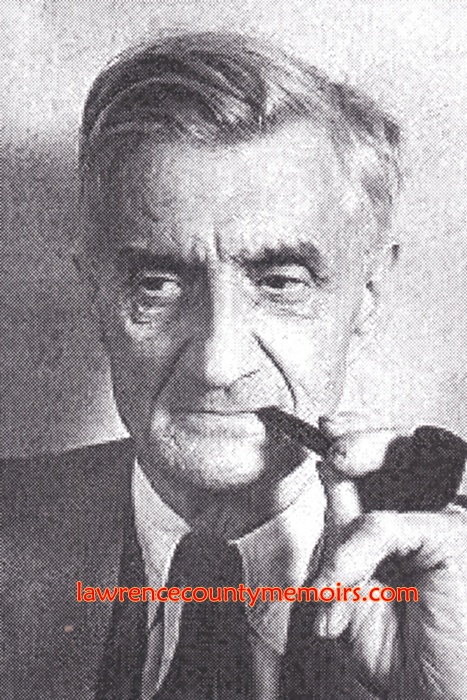
Comments
M DiThomas #
My father, who was born in 1921, used to tell a story about cutting school (North Street School) to go to jail to see a notorious woman killer. Apparently, anyone could view this woman in jail. He said she was blonde. I guess his story was true?
Mark Spires #
Law Man,Joe Chapman,kidnapped by the desperados,was my Grandpa.His bullet wounds left only his thumb and forefinger on his left hand,prompting fellow cowboys to name ol` Joe:“El Scorpion~”.Joe Chapman was a true to life cowboy,who loved his wife Icy,kids Hope and Barbara,who gave them six grandkids.Joe inspected cattle later in life,my brothers and I got to go with him,that was in the 1960`s.Western author Dan Woods also wrote a version of these people and events.
Brian Flamino #
My father Brady, and his older brother, Paul were named after the slain trooper. Both my father, and my Uncle Paul, are fantastic men, of the highest sincerity. Just as I’ve heard of Trooper Paul. I just lost my father, and this was a reminder of better times, when I would hear this story as a child.
Richard D. Anschutz #
I grew up hearing bits and pieces of the story from my mother. Apparently Brady Paul was a cousin to my uncle, Jack Priest. I knew those bits and pieces (the shooting and the ultimate fate of the pair) and have seen the memorial along the New Castle Road where the shooting took place, but did not know the rest of the story. I much appreciated this article as it completes the story for me. My thanks to the researcher and writer.
BevA #
Deputy R. Lee Wright, who died in Arizona, was my 3X great uncle. I’m glad I found this story. However, according to my research he was actually no relation to Sheriff Charles H. Wright.
Robert Bryan Davis #
Pearl Curry was my Grandmother, later Pearl Potter, my grandmother was Irene’s sister and Ray and Ruby were my Aunt and Uncle, I have been to there house many times in Bellaire, Ohio, Irene was my Great, Great Aunt, I hope she did not fire the fatal shot that killed Officer Paul, I also had a Aunt Martha and Uncle Victor Schoenon {spelling not correct} who lived in South Wheeling, who we visted quite often, also a Aunt Mamie, also a sister, Irene was buried in a unmarked grave next to her brother John Crawford, she lies to the left of him, did she fire the fatal shot and does she deserve this disrespect, I do not know?? But I must say, although I have never met her, I hope it isn’t!!!! God Bless all involved!!!!!!!
Robert Howell #
my grandfather from new martinsville wva was wrongly convicted of a robbery these two committed and served time in prison
Paul Moore #
My grandfather was officer Ernest Moore he retired from the state police many years after this i donated his hat with bullet holes in it to the pa state police museum
Comment